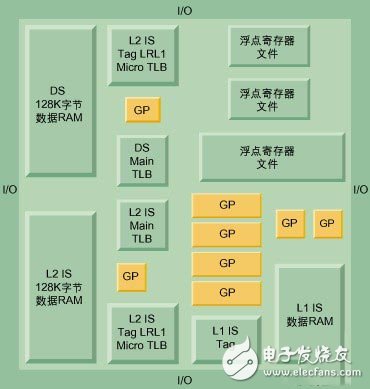As the level of integrated circuit manufacturing technology increases, more functions can be integrated on the semiconductor chip. In order to differentiate the product from competitors' products, integrating memory on the ASIC can reduce cost and power consumption, improve performance, and increase system level. Chip reliability. As the demand for embedded memory continues to grow, so does its complexity, density, and speed, and a need exists for a dedicated memory design approach.
Outsourced design of memory
Memory modules have relatively independent characteristics. In a clock system, it usually occupies a pipeline. From the perspective of cost and human resources, many chip developers outsource memory modules because they are compared with other semiconductor chips. It is much easier to define and separate memory modules. In addition, many factors have contributed to the development of memory editors and custom memory design companies, such as the standard module features of memory modules, the huge market demand for embedded memory, and the memory cores that employ new technologies unfamiliar to system designers. Meeting the urgent system design schedule requirements, the memory design company serves the system design company in a timely manner through on-board memory design.
When many companies outsource embedded memory design, many companies have been hesitant. In the outsourcing design process, the system designer should get the pin position, memory chip area and memory HDL model as early as possible, so that the system-on-chip can be launched in time and efficiently without worrying about the area of ​​the system chip. Performance and quality issues.
Another way to get an embedded memory design is to use a memory compiler that can design memory physical blocks quickly and inexpensively. Although this method is very efficient and fully suitable for standard memory structures, it has several drawbacks. Typically, compiled memory designs export a large number of memory modules and cause overall system performance degradation. In addition, when the system design needs to add new features, the design method is less flexible.
In contrast, customizing the design company's custom embedded memory design to memory is a great benefit. Custom memory can satisfy the system's sudden memory requirements, such as modifying logic to achieve logical compatibility with the memory core. Custom memory is not simply embedding a standard memory module on a chip, but then integrating the other logic of the memory to achieve the desired functionality. In fact, the designer directly implants the logic circuit into the memory module, so that the physical layout is closely integrated with the memory cells of the memory, which can reduce the total area of ​​the chip, thereby achieving higher storage density and improving the performance of the chip. Achieve high speed, compact, low power consumption and simple wiring design requirements.
The complexity of existing memory designs requires a complete design flow. The design methods presented in this paper include design concepts, netlist creation, design, routing, and verification of memory modules that ensure that memory modules work effectively when embedded in SoCs.
Memory design in RISC
In embedded memory designs of 500MHz, 64-bit RISC microprocessors, on-chip memory is fast enough and complex enough to match high-speed, complex microprocessors. Custom memory occupies more than 1/3 of the 200mm2 processor, including: primary and secondary caches, two-level translation lookaside cache (TLB) that translates virtual page addresses into physical addresses, and more for fixed-point and floating-point cores. Port register files as well as look-up tables (LUTs) and general purpose memories (GPs). The cache contains independent memory that implements data storage, identification, and LRU functionality. In addition to the multiport storage array, the register file contains ROM and CAM for address translation and naming logic (see Figure 1). In short, design 20 unique memories.

Figure 1 Logic unit ROM and CAM
The complexity and uniqueness of memory suggests that the use of memory compilers is not entirely feasible, and each type of embedded memory needs to be designed with new circuit techniques to meet the high performance, high density, low power and extremes of the microprocessor. Low noise requirements.
Such high-speed microprocessors must be fabricated using state-of-the-art 0.18μm, 6-layer copper dual damascene metal CMOS processes. Their extremely small feature size and high performance transistors make memory design a tough test because of narrow metal traces (lines). High than horizontal spacing is particularly susceptible to crosstalk and electron transfer effects, while low thresholds of transistors will result in reduced noise immunity.
This series high power density programmable dc electronic load provides three voltage ranges 200V DC Electronic Load System/600V DC Electronic Load System/1200V DC Electronic Load System. Supports CV, CC, CR and CP these 4 basic operating modes, as well as CV+CC, CV+CR, CR+CC these 3 complex operating modes. Complete protection includes OCP, OPP, OTP, over voltage and reverse alarm. Supports list function. RS232, RS485 and USB is the standard communication interfaces. LAN&GPIB communication card is optional. This series DC load can be applied to battery discharge, DC charging station and power electronics and other electronics products.Additionally, it can also work in single unit in 200V DC electronic load /600V DC Electronic Load /1200V DC electronic load .
Speical features as below:
â— Flippable front panel and color touch screen allow convenient access and operation
â— Provides four kinds of basic working mode such as CV/CC/CR/CP, and CV+CC/CV+CR/CR+CC complex operating modes
â— Adjustable current slew rate, adjustable CV loop speed
â— Ultra high precision voltage & current measurement
â— 50kHz high-speed CC/CR dynamic mode
â— 500kHz high-speed voltage and current sampling rate
â— Timing & discharging measurement for batteries
â— Short circuit test mode
â— Auto mode function provides an easy way to do complicated test
â— V-monitor/I-monitor
â— Full protection: OCP, OPP, OTP, over voltage and reverse alarm
â— Front panel USB interface supports data import and export
â— Using standard SCPI communication protocol
â— Smart fan control with lower noise and better for environment
DC Electronic Load System
DC Electronic Load System,electronic DC load,itech dc load
APM Technologies (Dongguan) Co., Ltd , https://www.apmpowersupply.com